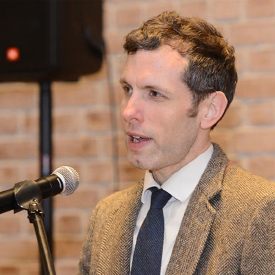Rendering Reality
A Conversation with Joshua Hren on His Manifesto Contemplative Realism

Joshua Hren is founder of Wiseblood Books and co-founder of the Master of Fine Arts in Creative Writing at the University of St. Thomas. He has published seven books, including two short story collections, a collection of poetry, a work of political philosophy inspired by J.R.R. Tolkien; and most recently, “How to Read (and Write) Like a Catholic,” the novel “Infinite Regress,” and the theological-aesthetical manifesto “Contemplative Realism.”
Dr. George Harne, executive dean of Arts & Sciences at UST, sat down with Hren to discuss how man’s ability to “see” is in decline and what Hren hopes to do with his book that became a movement.
Q: You call Contemplative Realism a “manifesto.” Why? Are not manifestos the stuff of radical politics?
A: In the middle of the 20th century, the Thomistic philosopher Josef Pieper looked around with the eyes of his soul and saw that, in a bad way, “man’s ability to see is in decline.” It is all too easy to wax nostalgic, and I always worry that narratives of decline are overstating how awful things are now or exaggerating how grand things once were in some golden age gone. However, I do not think anyone can deny that the diagnosis of Pieper has not suffered any inflation at all. Our very sense of life and our trust that we can know the truth are all threatened by ideological oversimplification and dulled by distraction. Several powerful, influential technological innovations that promised to provide clear windows instead function as unreal filters, dulling the soul’s depth perception. These filters are hugely consequential because we need to see and see fully to act well. Therefore, if we are going to get real, we have to start with an urgent alarm over how radically “man’s ability to see is in decline.” Thus the manifesto. My little book is a limited intervention but an impassioned summons seeking to provoke all artists and people of goodwill into continual attentiveness, self-correction, and commitment to an unflinching but grateful gaze.
Q: From what I gather, contemplative realism is not an outright rejection of realism but builds on and develops it. What is “realism,” its limits, and how does the contemplative dimension change things?
A: Realism – I refer to the literary form firmed up by writers like Flaubert and Henry James, but it has counterparts in the visual arts and elsewhere – has gifted literature and its readers with considerable gains. With its insistence upon exacting explorations of characters’ psychological workings, with its willingness to countenance difficulties, the hard won-truth, and move beyond the novel’s youthful sentimentality. However, so-called “realism” typically gives short shrift to the unseen and the supernatural – which comprise most of reality. Instead of subscribing to the usual realist prejudice that “supernatural” things are likely projections of our fantasies, contemplative realism hints at the unseen as an objectively existing realm. It does so, for instance, by walking the reader from traces of God in the created world to the Creator Himself. Contemplative realism is committed to rendering the hard parts of reality, but it also scrounges for redemption amidst uncanny or unexpected places or people.
Q: So, one aspiration of this aesthetic is to seek to represent nature consciously, not just human beings, as part of the reality drama. Could you unpack the place of God’s creation and the non-human elements of a contemplative realist’s art?
A: Nature croons with sublimity and beauty. It also groans for redemption: witness predation and famine, for instance. Willa Cather exemplifies the truthful tension the contemplative realist tries to capture. In her novel, “Death Comes for the Archbishop,” nature contains “geometrical nightmares;” some of the created world is kind of overwhelming, but it also can bring us to silent gratitude and awe: A lost priest at the novel’s start encounters a “cruciform tree” at a crucial moment. How few novels and novelists hold these disparate characteristics of nature in tension. How few books render the traces of God in all His creation – from the ant to the mountain – while reminding the reader that man remains the peak. There is so much room for art – painting, fiction, or film – to move in that direction.

“Contemplative realism is committed to rendering the hard parts of reality, but it also scrounges for redemption amidst uncanny or unexpected places or people.”
-Joshua Hren